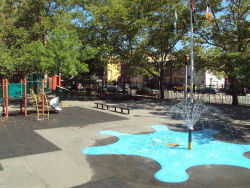Howard Playground
Howard Playground
William Howard (1725-1777) owned the Rising Sun Tavern, also known as the Howard Halfway House because of its location between Brooklyn Village and the town of Jamaica at the intersection of the Bedford and Jamaica Turnpikes (now the corner of Broadway and Jamaica Avenue). The tavern lodged travelers, served as a gathering place, and sold basic supplies to the area farmers. Its design was unusual – the Rising Sun had two bars, segregated so its Dutch patrons would not have to endure the perceived indignity of drinking with their slaves.
In August 1776, British General William Howe (1729-1814) advanced on American troops, an action which culminated in the Battle of Brooklyn. During the middle of the night, Howe stopped at the Rising Sun Tavern and took Howard and his family prisoner. Howard supported American independence and tried to refuse aiding the general. However Howe threatened to have Howard shot in the head if he did not comply, so Howard and his fourteen year-old son, also named William (1762-1854), led the British along the Rockaway Path (which ran through what is now the Evergreen Cemetery). They avoided Jamaica Pass, which they thought was heavily defended by American troops.
As it turned out, there were only five American soldiers at Jamaica Pass. These soldiers were supposed to fall back and raise the alarm at the approach of British troops. By circumventing the pass with Howard’s help, the English took the lookout by surprise and easily captured these few guards. The British then attacked the American troops from behind their fortified position, nearly destroying it in its first military defeat. General George Washington barely escaped from New York with his troops.
Howard and family remained prominent in the area even after the end of the Revolutionary War, and Howard Avenue was laid out on the Map of the City of Brooklyn in 1839 between Broadway and Eastern Parkway Extension. The avenue gave its name to the Howard Houses (1955), which passed it to Howard Playground (1956), and Howard Pool (1968).
In 1953 the city bought the land for this park along with the site where the Howard Houses would be built. The houses were intended to provide better homes and more recreational space for people living in what was considered to be substandard housing. While most of the buildings on the block were demolished to make room for the new housing, the Brownsville Branch of the Brooklyn Public Library (1908) stood and remains next to the park. It was one of many libraries built throughout the United States, England, and other English speaking countries with money donated by industrialist Andrew Carnegie (1835-1919). The park was originally named the Howard Houses Playground, but the name was shortened to Howard Playground in 1987.
The park opened on September 12, 1956, and includes two small basketball courts and three additional basketball hoops, two handball courts, and a play area with safety surfacing that features slides, poles, various wooden climbing blocks, and swings for both toddlers and older children. There are also benches, two checkerboard tables, a drinking fountain and several mature London plane trees (Platanus x acerifolia).
Check out your park's Vital Signs
Clean & Safe
Green & Resilient
Empowered & Engaged Users
Share your feedback or learn more about how this park is part of a
Vital Park System

